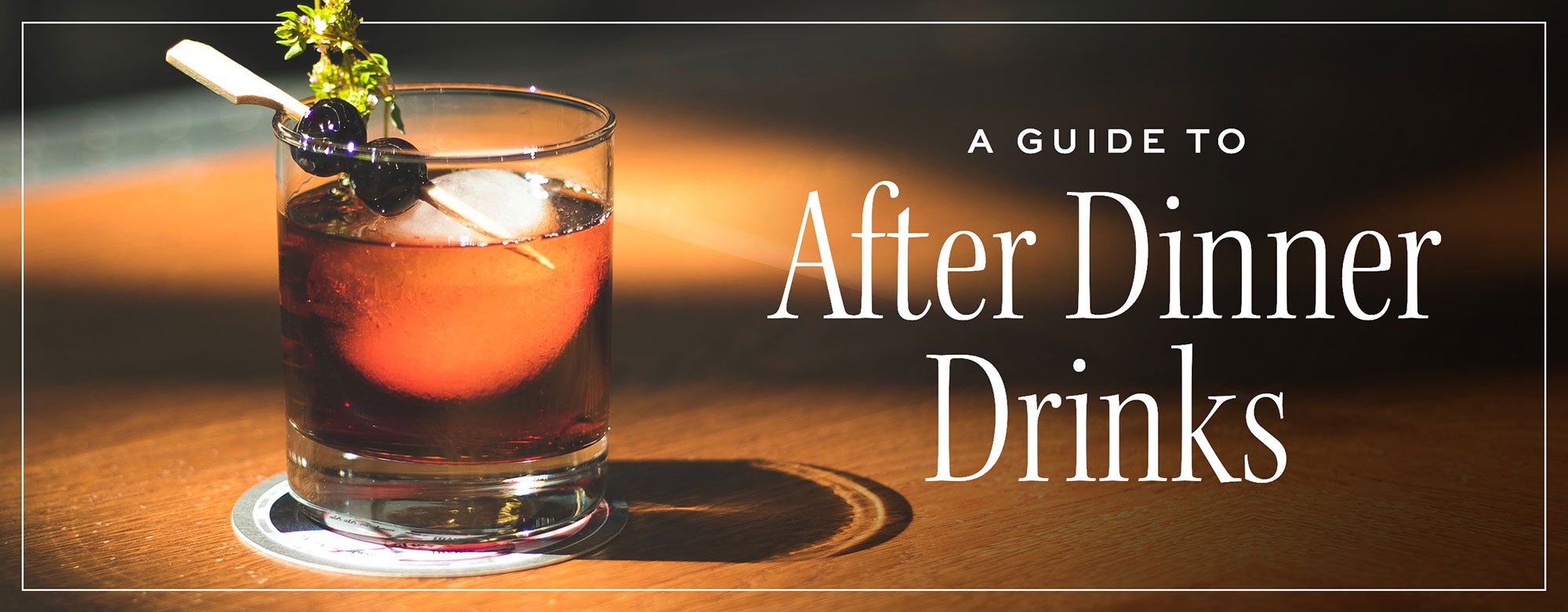Expanding your cocktail menu to include after dinner drinks is a great way to enhance the dining experience for your guests. The right after-dinner liqueur adds the perfect ending to a delicious dinner, especially after a full-course meal that has left your guests feeling heavy. We've made a list of some of the most popular digestifs and after dinner drinks to help you build your drink menu.
Shop All Cordial GlassesWhat Is an After Dinner Drink Called?
Digestif (pronounced dee-jes-teef) is another name for an after dinner drink, or an alcoholic beverage served after dinner to help improve digestion. These drinks are served in small amounts, usually in a cordial glass, and are intended to be sipped. The ideal digestif stimulates digestion after a large meal, soothing the stomach if you've over-indulged a bit too much.
Types of Digestifs
What makes a good digestif? Any drink can be an after dinner drink if you enjoy it, but a classic digestif is meant to help with digestion. Most after dinner drinks have a high alcohol content (ABV), a concentrated flavor that is best enjoyed slowly, or a bitterness that can be an acquired taste for some. There are several types of digestifs to choose from and most will fall under one of these types:
- Aged Spirits - Aged spirits like brandy or scotch can be sipped neat for a relaxing after dinner drink.
- Fortified Wines - Fortified wine, or wine that contains a distilled spirit, is a popular digestif choice.
- Liqueurs or Cordials - Herbal liqueurs that settle the stomach are a soothing post-dinner remedy.
- Digestif Cocktails - A classic cocktail like the Old Fashioned makes a great nightcap.
Digestif Drinks
Digestif alcohol eases the feeling of fullness after a large meal. It also gives guests time to relax and chat a little bit longer before calling it a night. For operators, adding after dinner drinks to the menu increases the alcohol sales per table and also encourages guests to order more courses, like a dessert or cheese platter. Check out some of the most popular options for your post-dinner drink list:
1. Brandy

Brandy has been served as an after dinner drink for hundreds of years. In fact, this warming spirit was first produced for medicinal purposes. Physicians in France named brandy l'eau de vie, which translates to "water of life". It was used as an antiseptic, an anesthetic, and finally as a digestif to soothe the stomach.
Today, brandy is enjoyed for its nuanced flavors and the warming effect of its high alcohol content. Unlike other types of after dinner alcohol, brandy doesn't contain herbs and spices that soothe the stomach. Instead, brandy calms the drinker and relaxes the stomach lining. It's also considered a helpful sleeping aid.
What Does Brandy Taste Like?
Brandy retains the flavors of the fruit used in distillation, which could be grapes, apples, or cherries. It has a deep warmth and a subtle sweetness. After barrel-aging, the brandy will develop notes of oak and spice.
Cognac vs Brandy
Cognac is a type of brandy that must be produced in the Cognac region of Southwest France. Just like certain cheeses that are identified by geographical indications, brandy production must adhere to strict rules in order to be labeled as Cognac.
- Best Glass for Brandy - Brandy snifter
- Brandy Serving Temperature - Room temperature
- Brandy Alcohol Percentage - 35% to 60% ABV
2. Chartreuse

Chartreuse is the brand name of a unique herbal liqueur produced by the monks of the Grand Chartreuse monastery in France. The first thing you'll notice about Chartreuse is its striking green color, which comes from a secret recipe containing 130 herbs and spices. Like many digestifs, this potent liqueur was first produced as a medicinal tonic. It became so popular as a regular beverage that the monks altered their recipe slightly to make the liqueur more drinkable.
What Does Chartreuse Taste Like?
The Carthusian monks produce two types of Chartreuse - green and yellow. Green chartreuse is considered more pungent, with peppery, minty, and herbaceous flavors. Yellow Chartreuse is mellow with sweet, spicy, or floral notes.
- Best Glass for Chartreuse - Cordial or liqueur glass with a flared rim
- Chartreuse Serving Temperature - Best served on ice or chilled to about 52 or 53 degrees Fahrenheit
- Chartreuse Alcohol Percentage - Green Chartreuse 55% ABV; Yellow Chartreuse 40% ABV
3. Sherry

Sherry is a fortified wine with an old-fashioned reputation, but there's much more to this nuanced after dinner drink than you may know. Sherry is a beloved drink in its native home of Spain, and it's often enjoyed with tapas during "sherry hour". Here in the US, sherry is seeing a resurgence and gaining some well-deserved appreciation.
Authentic Spanish sherry must be produced in the region called the "sherry triangle" and starts its life as a wine made with white grapes. The wine is fortified with the addition of more alcohol and placed in wooden casks for aging.
What Does Sherry Taste Like?
There's a misconception that all sherry is syrupy sweet, but each variety of sherry wine has unique flavors. There are dry styles like Fino sherry and Manzanilla sherry that are briny and savory. Sweet sherries like Pedro Ximenez (PX for short) and cream sherry have notes of dried fruit, spices, and chocolate. One of the most complex styles is Amontillado sherry, which develops refined flavors of oak, tobacco, or leather as it ages.
- Best Glass for Sherry - Sherry glass
- Sherry Serving Temperature - Fino and Manzanillo should be well chilled to 44 to 48 degrees Fahrenheit; other varieties range from 50 to 57 degrees Fahrenheit
- Sherry Alcohol Percentage - 16% to 20% ABV
5. Amaro

Amaro is the name for a class of Italian herbal liqueur that is commonly enjoyed as an after dinner drink or digestivo. There are several brands of Amari (the plural form of Amaro), each with its special recipe. Campari, Aperol, and Cynar are all examples of Amari.
The common factor between all brands of Amari is a bitter-sweet flavor that comes from botanical ingredients like herbs, flowers, and bark. The term Amaro translates to bitter in Italian. Not to be confused with cocktail bitters that are used as a flavoring in mixed drinks, Amari are served on their own and sipped slowly for a post-meal drink.
What Does Amaro Taste Like?
Amari are usually bitter-sweet and herbaceous. Some are citrusy and piney, while others are smokey with notes of caramel or licorice. Cynar is a brand of Amaro that gets its flavor from Italian artichokes, and Fernet-Branca is dominated by menthol. There are dozens of Amari brands and each has a signature flavor.
- Best Glass for Amaro - Cordial or liqueur glass
- Amaro Serving Temperature - Serve over ice or room temperature neat
- Amaro Alcohol Percentage - 16% to 35% ABV
6. Port Wine

Port wine, sometimes shortened to just port, is a fortified wine produced in Portugal. To be considered an authentic port, the wine must be made in the Doura Valley from native grape varieties. The name port comes from the coastal city of Porto.
A glass of port wine can be enjoyed with a cheese plate, a rich dessert, or as an after dinner drink. Often thought of as a deep-red dessert wine, port is also available in styles that are dry, white, or rose. Dark varieties of port pair well with chocolate while white varieties complement fruit and lighter desserts.
What Does Port Wine Taste Like?
Ruby port, a red unaged port wine, is sweet and bright with notes of ripe fruit. Tawny port is barrel-aged and develops a deeper flavor profile with notes of spice, dried fruits, and chocolate.
- Best Glass for Port Wine - Port wine glass
- Port Wine Serving Temperature - 60 to 64 degrees Fahrenheit
- Port Wine Alcohol Percentage - 20% ABV
7. Grappa

Grappa is an Italian after dinner spirit that is made from the leftover grape seeds, skins, and stems from wine-making. The use of these waste materials, called pomace, makes grappa production a zero-waste process. Just like some of the other after dinner drinks on this list, authentic grappa is protected by a geographical indication and must be made in Italy from distilled pomace.
In Italy, it's a common ritual to pair grappa with coffee. The cafe corretto is a type of coffee drink that combines espresso with a small amount of grappa.
What Does Grappa Taste Like?
Just like wine, the flavor of grappa is dependent on the grape varietals that make up the pomace. However, don't expect grappa to taste like wine. Grappa is considered a spirit, similar to brandy, and has a very high alcohol content that catches some people off-guard. Its flavor is sometimes described as a sweeter version of Cognac, with notes of berries, plums, and honey.
- Best Glass for Grappa - Grappa wine glass
- Grappa Serving Temperature - 48 to 55 degrees Fahrenheit
- Grappa Alcohol Percentage - 37% to 60% ABV
8. Aquavit

Aquavit, a beloved drink in Scandinavia, is a distilled spirit made from potatoes and grains and then flavored with herbs and botanicals. The herbal flavors of aquavit make it a great digestif to calm the stomach between courses or after a greasy meal. The word aquavit translates to "water of life," and it was used for medicinal purposes in the past.
This clear spirit is similar to vodka, but the key ingredient that sets aquavit apart is caraway. To be labeled as aquavit, caraway must be used to flavor the neutral spirit.
What Does Aquavit Taste Like?
The savory flavor of aquavit comes from aromatic herbs like caraway, dill, and anise. It's often compared to rye bread.
- Best Glass for Aquavit - Chilled shot glass or liqueur glass
- Aquavit Serving Temperature - Room temperature or chilled
- Aquavit Alcohol Percentage - 37.5% to 40% ABV
After dinner drinks aren't just an excuse for one more drink, they have a purpose. They make a great meal even more satisfying by alleviating fullness. You can promote the digestive benefits of after dinner drinks and create an enhanced dining experience for your guests by offering a digestif drink menu.



